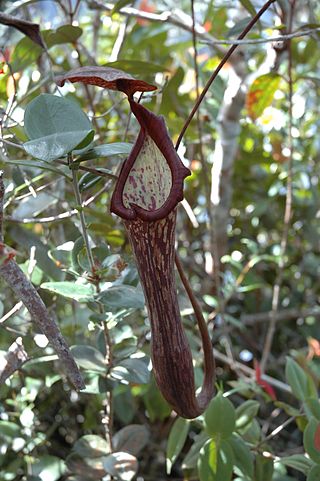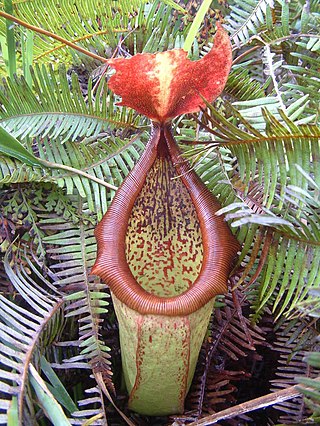
Nepenthes sibuyanensis is a tropical pitcher plant endemic to Sibuyan Island in the Philippines, after which it is named.

Nepenthes truncata is a tropical pitcher plant endemic to the Philippines. It is known from the islands of Dinagat, Leyte, and Mindanao. The species grows at an elevation of 0–1500 m above sea level. Nepenthes truncata is characterised by its heart-shaped (truncate) leaves and very large pitchers, which can reach up to 40 cm in height.

Nepenthes faizaliana is a tropical pitcher plant endemic to the limestone cliffs of Gunung Mulu National Park in Sarawak, Borneo. It is thought to be most closely related to N. boschiana.

Nepenthes alata is a tropical pitcher plant endemic to the Philippines. Like all pitcher plants, it is carnivorous and uses its nectar to attract insects that drown in the pitcher and are digested by the plant. It is highly polymorphic, and its taxonomy continues to be subject to revisions.

Nepenthes philippinensis is a tropical pitcher plant endemic to the Philippines. It is known from Palawan and the neighbouring Calamian Islands and Linapacan, where it grows at 0–600 metres (2,000 ft) above sea level.
Nepenthes danseri is a species of tropical pitcher plant. It is known only from the northern coast of Waigeo Island; plants from Halmahera, the largest of the Maluku Islands, are now recognised as belonging to a separate species, N. halmahera.

Matthew Hilary Peter Jebb is an Irish botanist and taxonomist specialising in the ant plant genera Squamellaria, Myrmecodia, Hydnophytum, Myrmephytum and Anthorrhiza, as well as the carnivorous plant genus Nepenthes.
Martin Roy Cheek is a botanist and taxonomist at the Royal Botanic Gardens, Kew.

Nepenthes insignis is a tropical pitcher plant endemic to New Guinea and surrounding islands. The specific epithet insignis is Latin for "distinguished" or "remarkable".

Nepenthes graciliflora is a tropical pitcher plant endemic to the Philippines. Long considered a synonym of N. alata, it was restored as a separate species in 2013 by Martin Cheek and Matthew Jebb. It has been recorded from the islands of Bohol, Leyte, Luzon, Mindanao, Mindoro, Panay, Samar, and Sibuyan, and following the redelimitation of N. alata is the most widespread Nepenthes species of the Philippines. It is known from mossy, submontane forest, generally at 800–1,280 metres (3,000–4,000 ft) altitude, though the type specimen from Sibuyan was collected at only 300 m (1,000 ft).

"An account of Nepenthes in New Guinea" is a monograph by Matthew Jebb on the tropical pitcher plants of New Guinea. It was published in the March 1991 issue of Science in New Guinea, a journal of the University of Papua New Guinea. It remains the only major monograph devoted to the tropical pitcher plants of the island.
Nepenthes abalata is a tropical pitcher plant known from three western islands of the Philippines: Culion, Cuyo, and Malalison. It has been recorded from coastal grassland and scrub at elevations of 0–20 m above sea level.

Nepenthes ramos is a tropical pitcher plant native to the northeastern Mindanao, Philippines. It is known from only a handful of herbarium specimens collected in 1919 at an elevation of 670 m above sea level. It likely grows in the forest on ultramafic soils.
Nepenthes ultra is a tropical pitcher plant native to the Philippine island of Luzon, where it grows at low altitude on ultramafic soils.

Nepenthes extincta is a tropical pitcher plant native to the Philippines. It is known only from Surigao del Sur, Mindanao, where it has been recorded at c. 400 metres (1,300 ft) altitude.
Nepenthes maryae is a tropical pitcher plant native to Central Sulawesi province on the Indonesian island of Sulawesi. It is known from a single herbarium specimen collected in 2000 on an undisclosed mountain at 2100 m above sea level, where the species grew in submontane mossy forest alongside N. eymae, N. nigra, and N. tentaculata. It is a member of section Tentaculatae, which also includes 8 other species from Borneo and Sulawesi: N. glabrata, N. hamata, N. muluensis, N. murudensis, N. nigra, N. pitopangii, N. tentaculata, and N. undulatifolia. Nepenthes maryae is distinguished from all other species in this group by the presence of short hairs on the lower surface of the pitcher lid and bracts on the majority of flowers.
Mallotus floribundus is a tree in the family Euphorbiaceae, in the Stylanthus section, native to Southeast Asia, Wallaceae, New Guinea and the Solomon Islands.












